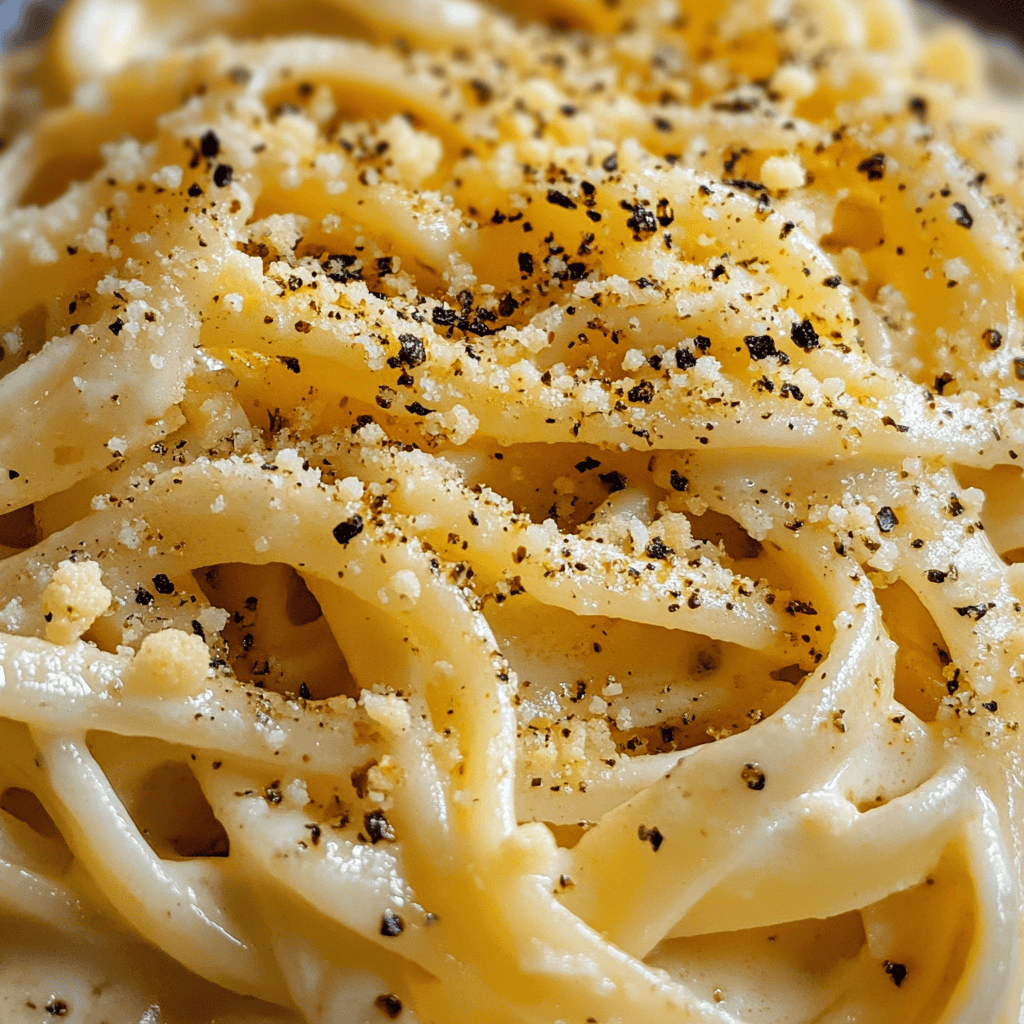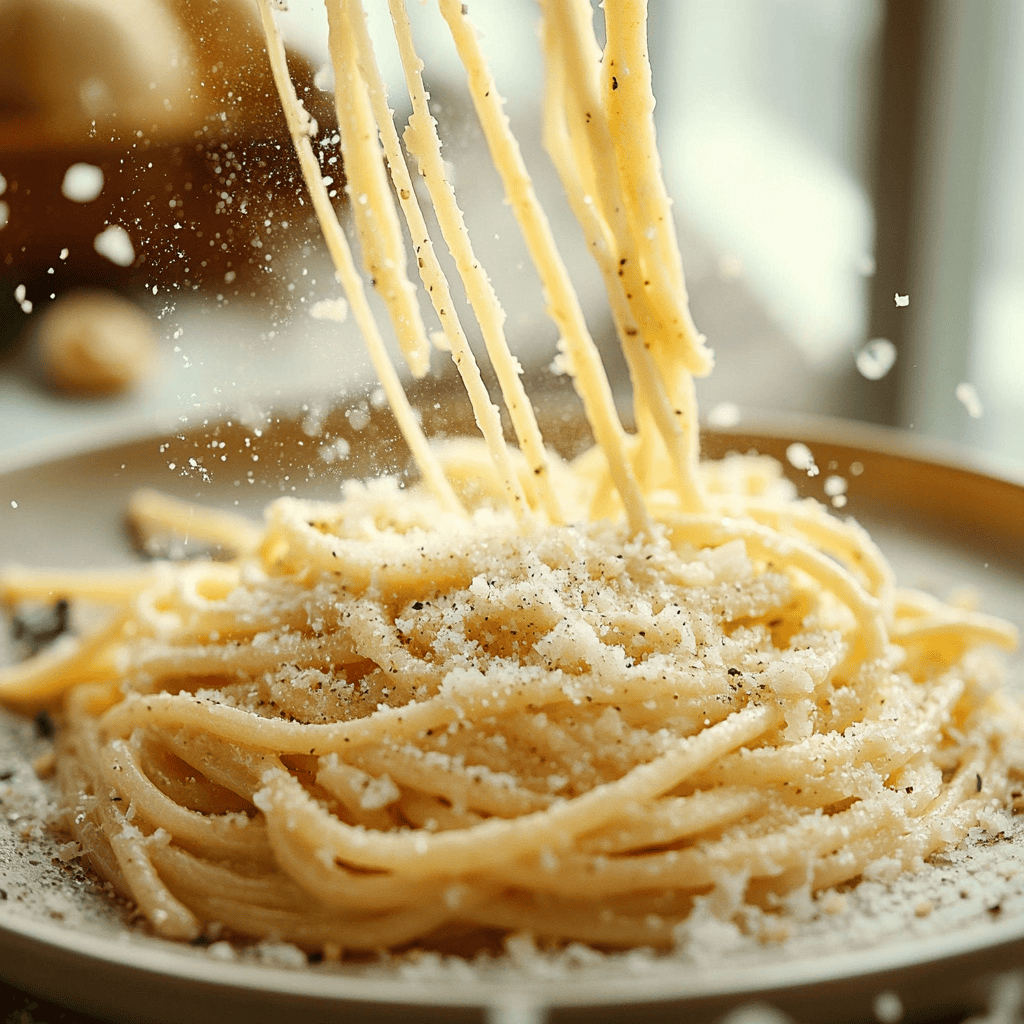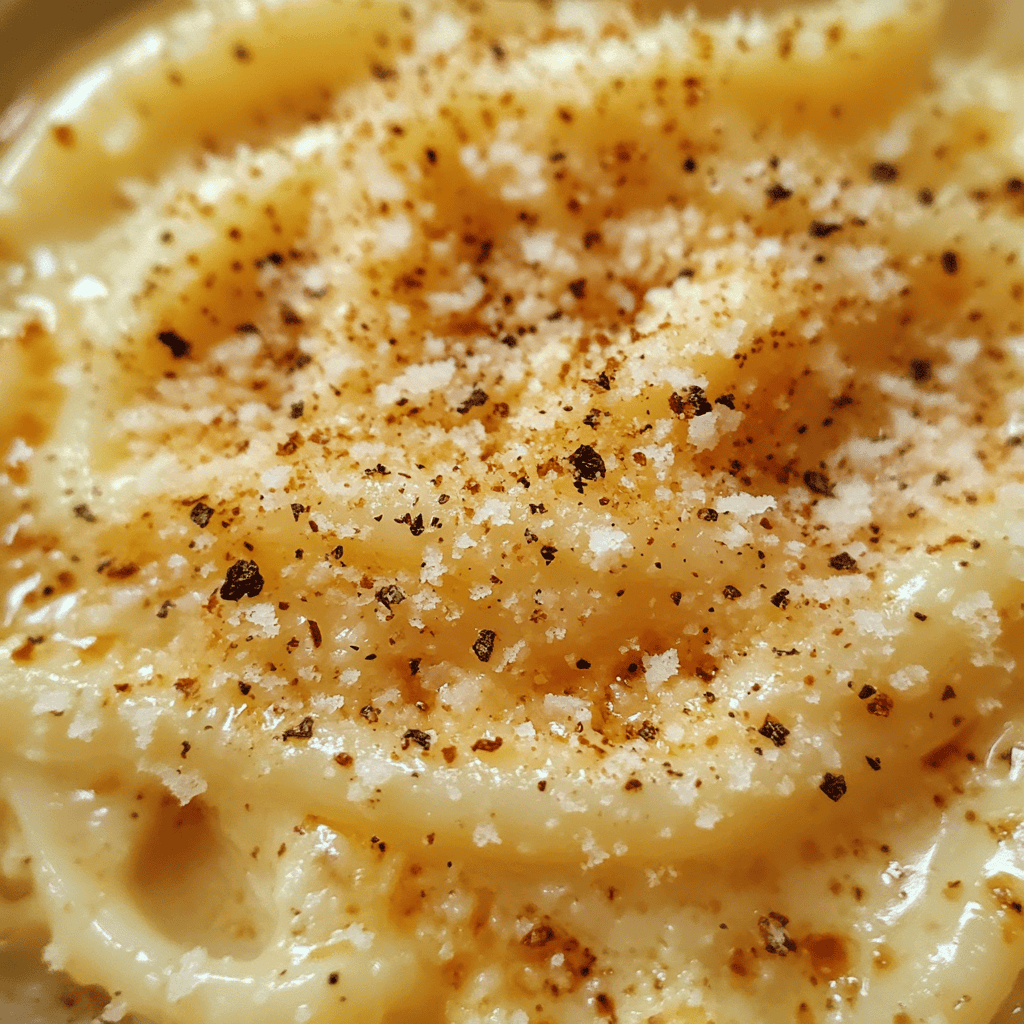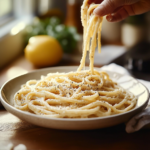Quick Overview
Cacio e Pepe is a classic Roman dish that highlights simplicity and flavor. With just three main ingredients—pasta, cheese, and black pepper—it brings comfort food to a whole new level. The beauty of this dish lies in its pure flavors and the technique used to combine them. Whether you are an experienced cook or a beginner, mastering this recipe will impress your friends and family alike. In less than 30 minutes, you can enjoy a bowl of creamy goodness that tastes like you’re dining at an Italian trattoria.
Ingredient Breakdown
Pasta
Pasta is the backbone of Cacio e Pepe. Use spaghetti or tonnarelli for the best texture. You’ll need about 400 grams (14 ounces) of dry pasta. Boil it in salted water until al dente; this helps the pasta maintain its bite while absorbing the sauce.
Pecorino Romano Cheese
The star ingredient in this dish is Pecorino Romano cheese. Use around 150 grams (5 ounces), finely grated. This sheep’s milk cheese brings a sharp, salty flavor that pairs beautifully with black pepper.
Black Pepper
Freshly cracked black pepper is essential for authenticity. You’ll need about 1 tablespoon for seasoning. It adds warmth and depth to the dish while balancing the richness of the cheese.
Step By Step Recipe: Cacio e Pepe
Step 1: Cook the Pasta
Begin by boiling water in a large pot. Once it reaches a rolling boil, add a generous amount of salt before adding your 400 grams (14 ounces) of spaghetti or tonnarelli. Stir occasionally and cook until just al dente according to package instructions, which usually takes about 8-10 minutes.
Step 2: Prepare the Cheese Mixture
While the pasta cooks, grate 150 grams (5 ounces) of Pecorino Romano cheese into a mixing bowl. Add freshly cracked black pepper to taste; about 1 tablespoon should enhance the flavors nicely. Mix them together until they form a fine powder-like consistency.
Step 3: Reserve Pasta Water
Before draining your pasta, reserve about 1 cup of the cooking water. This starchy water will help emulsify your sauce later on and give it that creamy texture we all love in Cacio e Pepe.
Step 4: Combine Pasta and Cheese
Once your pasta is cooked al dente, drain it quickly but do not rinse it under cold water; you want to keep that heat! Immediately transfer it into the mixing bowl with your cheese and pepper mixture while it’s still hot.
Step 5: Emulsify with Pasta Water
Gradually add reserved pasta water—start with half a cup—while tossing the pasta vigorously. The heat from the pasta will melt the cheese and create a creamy sauce that clings beautifully to each strand.
Step 6: Final Seasoning
Taste your dish before serving; if needed, add more freshly cracked black pepper or cheese according to your preference. Toss everything again to ensure even distribution of flavors throughout your creamy concoction.
Serving and Storing Tips
Serving Tip
Serve Cacio e Pepe immediately after preparing for optimal creaminess. Plate it hot in warm bowls and sprinkle extra Pecorino Romano on top along with more cracked black pepper for enhanced flavor and presentation.
Storing Tip
If you have leftovers, store them in an airtight container in the fridge for up to two days. To reheat, add a splash of reserved pasta water or olive oil in a pan over medium heat until warmed through; this helps restore some creaminess.
This simple yet delightful recipe for Cacio e Pepe showcases how minimal ingredients can create maximum flavor! Enjoy every cheesy bite!
Mistakes to avoid
One common mistake when preparing Cacio e Pepe is using the wrong type of cheese. Always opt for high-quality Pecorino Romano, as it melts beautifully and gives the dish its signature flavor. Avoid pre-grated cheeses; they often contain anti-caking agents that prevent proper melting.
Another mistake is adding too much water to your pasta cooking process. While a little starchy water can help bind the sauce, excessive water can dilute the flavors. Strain your pasta carefully, reserving just enough cooking water to create a creamy texture in your sauce.
Overcooking the pasta is also a frequent error. Aim for al dente to achieve that perfect bite. Remember, you will continue cooking the pasta slightly once you combine it with the sauce, so take it off the heat just before it’s fully cooked.
Failing to mix the cheese properly is another misstep. After cooking, allow some time for the cheese to meld with the pasta. If you add it too quickly or directly from the fridge, clumps may form instead of a smooth sauce.
Lastly, neglecting seasoning can ruin your Cacio e Pepe experience. Although Pecorino Romano adds saltiness, do not skip adding freshly cracked black pepper. Adjust this seasoning according to your taste preferences for a balanced dish.
Tips and tricks
To make perfect Cacio e Pepe, start by using high-quality ingredients. The simplicity of this dish means that every component counts. Choose fresh pasta if possible; it cooks quickly and enhances the texture of your meal. If using dried pasta, select high-quality brands for better results.
Next, focus on timing when boiling your pasta. Start cooking it right before you’re ready to prepare your sauce. This way, you can use hot pasta directly in your sauce without letting it cool down or overcook. Timing ensures everything comes together seamlessly for maximum flavor and consistency.
When mixing the cheese into your pasta, add a splash of reserved starchy water gradually while stirring vigorously. This helps in emulsifying both elements effectively, creating a creamy sauce rather than dry cheese clumps. The heat from the pasta will melt the cheese evenly and coat each strand beautifully.
Don’t forget about black pepper! Freshly cracked black pepper not only adds flavor but also elevates the dish’s aroma and visual appeal. Adjust this ingredient according to your preference for spice; some may prefer more for an extra kick.
Lastly, serve immediately after combining everything for optimum freshness. Cacio e Pepe tastes best when served hot straight from the pot onto warm plates or bowls. Garnish with additional cheese and freshly cracked pepper if desired to impress your guests or family members.
Suggestions for Cacio e Pepe
Consider pairing Cacio e Pepe with a crisp white wine like Pinot Grigio or Sauvignon Blanc; their acidity complements the richness of Pecorino Romano perfectly while cleansing your palate between bites.
For added texture and flavor contrast, serve alongside a simple arugula salad dressed with lemon vinaigrette. The peppery notes of arugula enhance the overall experience without overpowering it.
If you’re feeling adventurous, try adding sautéed mushrooms or roasted cherry tomatoes as toppings to enhance both taste and visual appeal in your dish. These elements provide extra layers of flavor while maintaining simplicity in preparation.
For those who enjoy a bit more spice in their meals, consider incorporating crushed red pepper flakes into your preparation or serving them on the side as an option for guests to customize their experience according to personal preferences.
Finally, make sure to use quality cookware when preparing this meal; non-stick pans work well as they prevent sticking during cooking while also allowing easy cleanup afterward—a win-win situation!
FAQs
What is Cacio e Pepe?
Cacio e Pepe is a traditional Roman pasta dish known for its simplicity and distinct flavors. It primarily consists of spaghetti or tonnarelli tossed with just three main ingredients: Pecorino Romano cheese, black pepper, and starchy pasta water. The name translates to “cheese and pepper,” highlighting these key components that make this dish so beloved by many around the world.
Can I use other types of cheese in Cacio e Pepe?
While Pecorino Romano is traditional and recommended for authentic flavor profile purposes, you can experiment with other cheeses like Parmigiano-Reggiano if desired. However, be aware that substituting may alter both taste and texture significantly; stick closely to original ingredients whenever possible for best results.
How do I achieve creaminess in my Cacio e Pepe?
To achieve that coveted creamy texture in Cacio e Pepe without using cream or butter, rely heavily on reserved starchy pasta water combined with freshly grated Pecorino Romano cheese mixed thoroughly into hot pasta after draining it appropriately—this technique creates an emulsion yielding an incredibly smooth finish without any clumps!
Is Cacio e Pepe suitable for vegetarians?
Yes! Cacio e Pepe is entirely vegetarian-friendly since it contains no meat products—just pasta paired with cheese and spices—making it an excellent option for those following vegetarian diets who still want something hearty yet satisfying.
Can I make Cacio e Pepe ahead of time?
While it’s best enjoyed fresh due to its creamy texture quickly compromised upon cooling down over time; you can prepare individual components like cooked spaghetti/pasta separately ahead but should combine them right before serving—the key here is ensuring optimal freshness remains intact throughout preparation!
What variations exist within this classic recipe?
Cacio e Pepe lends itself well towards various adaptations based on personal preferences! Consider adding sautéed vegetables such as spinach or peas alongside protein additions like pancetta or bacon bits if desired—but remember these changes shift away from traditional roots while still keeping core elements intact!
Summary
In summary, mastering Cacio e Pepe requires careful attention to detail regarding ingredient quality and preparation methods. Avoid common mistakes like overcooking pasta or failing to mix cheese properly while utilizing tips on timing and emulsification techniques for optimal results! Enhance this classic dish through thoughtful pairing suggestions such as crisp salads or wines tailored specifically towards balancing flavors effectively—all leading toward creating memorable dining experiences!
Cacio e Pepe
Description
Cacio e Pepe is a classic Roman dish that highlights simplicity and flavor. With just three main ingredients—pasta, cheese, and black pepper—it brings comfort food to a whole new level. The beauty of this dish lies in its pure flavors and the technique used to combine them. Whether you are an experienced cook or a beginner, mastering this recipe will impress your friends and family alike. In less than 30 minutes, you can enjoy a bowl of creamy goodness that tastes like you’re dining at an Italian trattoria.
Ingredients
Pasta
Pasta is the backbone of Cacio e Pepe. Use spaghetti or tonnarelli for the best texture. You’ll need about 400 grams (14 ounces) of dry pasta. Boil it in salted water until al dente; this helps the pasta maintain its bite while absorbing the sauce.
Pecorino Romano Cheese
The star ingredient in this dish is Pecorino Romano cheese. Use around 150 grams (5 ounces), finely grated. This sheep’s milk cheese brings a sharp, salty flavor that pairs beautifully with black pepper.
Black Pepper
Freshly cracked black pepper is essential for authenticity. You’ll need about 1 tablespoon for seasoning. It adds warmth and depth to the dish while balancing the richness of the cheese.





